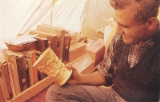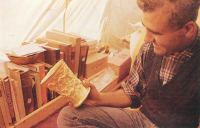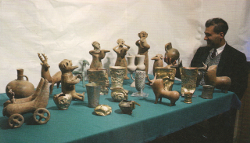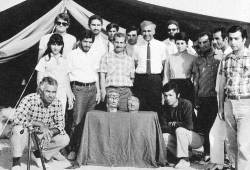
Ezzat Negahban
Encyclopedia
Ezatollah Negahban was an Iran
ian archaeologist known as the father of Iran
ian modern archaeology
.

, Iran
. After graduating from Firouz Bahram High School
, In 1949 he finished his BA in archaeology at the University of Tehran
and in 1954 he received his MA in archaeology from the University of Chicago
, after completing his thesis under Donald McCown. He was appointed Associate Professor in the Department of Archaeology, University of Tehran, in 1955, and was made a full Professor in 1962. He served as Chairman of the Department from 1967 to 1978, and as Dean of the Faculty of Letters and Humanities from 1975 to 1979. He was Technical Director of the Iranian Archaeological Service from 1960 to 1965, and served as Technical Advisor of the Iranian Ministry of Culture from 1965 to 1979. He served as a Visiting Curator at the University Museum of the University of Pennsylvania
from 1980 until 2000.
 He was chief scientist in many excavations on Iran
He was chief scientist in many excavations on Iran
ian ancient sites including Marlik
, near Rudbar
, Haft Tepe
, near Susa
and Ahvaz, where he founded a museum to showcase artifacts from the site, and on the plane of Hamadan Province
, where a training center for students was established.
Among the critical contributions of Prof. Negahban to Iranian archaeology were his reforms to the curriculum of the Department of Archaeology at the University of Tehran, and the founding of the Institute of Archaeology. While he introduced and encouraged a more scientific approach to the field from the time he was appointed to the Department of Archaeology in 1956, starting in 1967, when he became Chairman of the Department, he reworked the curriculum around a significant component of fieldwork, mandatory for all students starting in 1970-1971. To facilitate this he established a base-camp of the Department's field school on the Qazvin Plain at the site of a restored Safavid caravanserai
, and secured a long-term permit to conduct field work from the Archaeological Service of Iran. Having introduced a significant practical component to the Department, he introduced a Master's program, including further fieldwork at the Haft Tepe excavation in Khuzestan Province
during the winter seasons. The Institute for Archeology, which he founded in 1959 and where he served as Director until 1979, played a critical role in these improvements by providing instructors and students with office space, and laboratory and library facilities to analyse the results of fieldwork and publish articles. He built on these successes by securing scholarships for the pursuit of PhDs by students abroad.
He was also a good friend of British archaeologist Sir Max Mallowan
, former widower of Agatha Christie
.

Iran
Iran , officially the Islamic Republic of Iran , is a country in Southern and Western Asia. The name "Iran" has been in use natively since the Sassanian era and came into use internationally in 1935, before which the country was known to the Western world as Persia...
ian archaeologist known as the father of Iran
Iran
Iran , officially the Islamic Republic of Iran , is a country in Southern and Western Asia. The name "Iran" has been in use natively since the Sassanian era and came into use internationally in 1935, before which the country was known to the Western world as Persia...
ian modern archaeology
Archaeology
Archaeology, or archeology , is the study of human society, primarily through the recovery and analysis of the material culture and environmental data that they have left behind, which includes artifacts, architecture, biofacts and cultural landscapes...
.

Biography
Prof. Ezat O. Negahban was born AhvazAhvaz
-History:For a more comprehensive historical treatment of the area, see the history section of Khūzestān Province.-Ancient history:Ahvaz is the anagram of "Avaz" and "Avaja" which appear in Darius's epigraph...
, Iran
Iran
Iran , officially the Islamic Republic of Iran , is a country in Southern and Western Asia. The name "Iran" has been in use natively since the Sassanian era and came into use internationally in 1935, before which the country was known to the Western world as Persia...
. After graduating from Firouz Bahram High School
Firouz Bahram High School
Firooz Bahram High School is one of Tehran's oldest high schools still in operation.-History:Built in 1932, it was constructed on the property of Zoroastrians such as Ardeshir Kiamanesh. The school was named after an Iranian Zoroastrian that died in the Meditarranean in World War I...
, In 1949 he finished his BA in archaeology at the University of Tehran
University of Tehran
The University of Tehran , also known as Tehran University and UT, is Iran's oldest university. Located in Tehran, the university is among the most prestigious in the country, and is consistently selected as the first choice of many applicants in the annual nationwide entrance exam for top Iranian...
and in 1954 he received his MA in archaeology from the University of Chicago
University of Chicago
The University of Chicago is a private research university in Chicago, Illinois, USA. It was founded by the American Baptist Education Society with a donation from oil magnate and philanthropist John D. Rockefeller and incorporated in 1890...
, after completing his thesis under Donald McCown. He was appointed Associate Professor in the Department of Archaeology, University of Tehran, in 1955, and was made a full Professor in 1962. He served as Chairman of the Department from 1967 to 1978, and as Dean of the Faculty of Letters and Humanities from 1975 to 1979. He was Technical Director of the Iranian Archaeological Service from 1960 to 1965, and served as Technical Advisor of the Iranian Ministry of Culture from 1965 to 1979. He served as a Visiting Curator at the University Museum of the University of Pennsylvania
University of Pennsylvania
The University of Pennsylvania is a private, Ivy League university located in Philadelphia, Pennsylvania, United States. Penn is the fourth-oldest institution of higher education in the United States,Penn is the fourth-oldest using the founding dates claimed by each institution...
from 1980 until 2000.

Iran
Iran , officially the Islamic Republic of Iran , is a country in Southern and Western Asia. The name "Iran" has been in use natively since the Sassanian era and came into use internationally in 1935, before which the country was known to the Western world as Persia...
ian ancient sites including Marlik
Marlik
Marlik is an ancient site near Roudbar in Gilan, north of Iran. The site of a royal cemetery, and artifacts found at this site date back to 3,000 years ago. According to G.N.Kurochkin, the archeological monuments Indo-Iranians and show similarities to the descriptions of the Avesta Yashts.-...
, near Rudbar
Rudbar
Rudbar is a city in and the capital of Rudbar County, Gilan Province, Iran. At the 2006 census, its population was 11,454, in 3,303 families....
, Haft Tepe
Haft Tepe
Haft Tepe is an archaeological site situated in the Khuzestan Province in southwestern Iran. At this site the remains of the Elamite city of Kabnak were discovered in 1908, and excavations are still carried out.-History:...
, near Susa
Susa
Susa was an ancient city of the Elamite, Persian and Parthian empires of Iran. It is located in the lower Zagros Mountains about east of the Tigris River, between the Karkheh and Dez Rivers....
and Ahvaz, where he founded a museum to showcase artifacts from the site, and on the plane of Hamadan Province
Hamadan Province
Hamedan Province is one of the 31 provinces of Iran. Its center is Hamedan city. The province of Hamedan covers an area of 19,546 km². In the year 1996, Hamedan province had a population of approximately 1.7 million people....
, where a training center for students was established.
Among the critical contributions of Prof. Negahban to Iranian archaeology were his reforms to the curriculum of the Department of Archaeology at the University of Tehran, and the founding of the Institute of Archaeology. While he introduced and encouraged a more scientific approach to the field from the time he was appointed to the Department of Archaeology in 1956, starting in 1967, when he became Chairman of the Department, he reworked the curriculum around a significant component of fieldwork, mandatory for all students starting in 1970-1971. To facilitate this he established a base-camp of the Department's field school on the Qazvin Plain at the site of a restored Safavid caravanserai
Caravanserai
A caravanserai, or khan, also known as caravansary, caravansera, or caravansara in English was a roadside inn where travelers could rest and recover from the day's journey...
, and secured a long-term permit to conduct field work from the Archaeological Service of Iran. Having introduced a significant practical component to the Department, he introduced a Master's program, including further fieldwork at the Haft Tepe excavation in Khuzestan Province
Khuzestan Province
Khuzestan Province is one of the 31 provinces of Iran. It is in the southwest of the country, bordering Iraq's Basra Province and the Persian Gulf. Its capital is Ahwaz and covers an area of 63,238 km²...
during the winter seasons. The Institute for Archeology, which he founded in 1959 and where he served as Director until 1979, played a critical role in these improvements by providing instructors and students with office space, and laboratory and library facilities to analyse the results of fieldwork and publish articles. He built on these successes by securing scholarships for the pursuit of PhDs by students abroad.
He was also a good friend of British archaeologist Sir Max Mallowan
Max Mallowan
Sir Max Edgar Lucien Mallowan, CBE was a prominent British archaeologist, specialising in ancient Middle Eastern history, and the second husband of Dame Agatha Christie.-Life and work:...
, former widower of Agatha Christie
Agatha Christie
Dame Agatha Christie DBE was a British crime writer of novels, short stories, and plays. She also wrote romances under the name Mary Westmacott, but she is best remembered for her 66 detective novels and 14 short story collections , and her successful West End plays.According to...
.
Projects

- Principal Excavations
- Mehranabad, 1961
- Marlik, 1961-1962
- Haft Tepe, 1965-1979
- Qazvin Plain, 1970-1979
- Other Projects
- Survey of Khorasan along Soviet border, 1965
- Survey of Kalardasht Plain, 1975-1976
Books
(In English)- 1964, Preliminary report on Marlik excavation: Gohar Rud expedition ; Rudbar. 1961-1962. Iranian Archcological Service, Tehran.
- 1977, A Guide of Haft Tepe Excavation and Museum, Ministry of Culture and Art, Tehran.
- 1983, Metal vessels from Marlik. Beck. Munich.
- 1991, Excavations at Haft Tepe, Iran. University Museum of Archaeology and Anthropology, Philadelphia. (ISBN 0-934718-89-X)
- 1995, Weapons from Marlik. Reimer. Berlin.
- 1995, Marlik : The Complete Excavation Report. (University Museum Monograph ; 87), University of Pennsylvania Museum Publication. (ISBN 0-924171-32-4)
Awards
- 1999 Medal for Cultural Heritage, Ministry of Culture and Islamic Guidance, Iran -- For a lifetimes service in the field of Archaeology
- 1992 Award for Book of the Year, Ministry of Culture and Islamic Guidance, Iran -- For the Persian edition of "Excavations at Haft Tepe, Iran"

